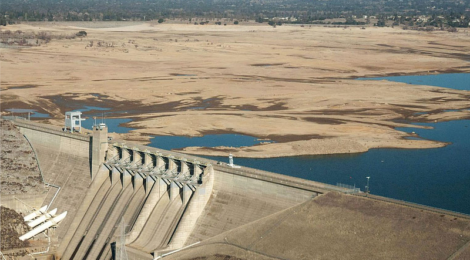
Warmer Oceans Lead To Prolonged California Drought
In climate science ‘models predict’ that warming of the air and oceans leads to more evaporation and that moisture laden air must lead to more rain…. bzzzt!
Now a new detailed history of California drought published in the Journal Nature covering a period of ten thousand years proves just the opposite.
It is a warm ocean and its cloudless skies that is associated with drought and present conditions portend a drought in California and the Western USA lasting centuries to millennia.
That is our fate unless we do something about the collapse of ocean pastures and restore lost plankton cooling in the Pacific.
A new study, published this week in the Nature journal Scientific Reports, reveals how shifts in climate and ocean conditions are closely correlated with repeated centuries-long and even millennia-long periods of California drought and drought throughout associated Western North American airsheds over the past 10,000 years. The researchers focused on repeating phenomena that are familiar to the world of climatology — sun spots, a slightly different earth orbit, and a decrease in volcanic activity, aka diminished dust. During such times the oceans to the west of North America warmed.
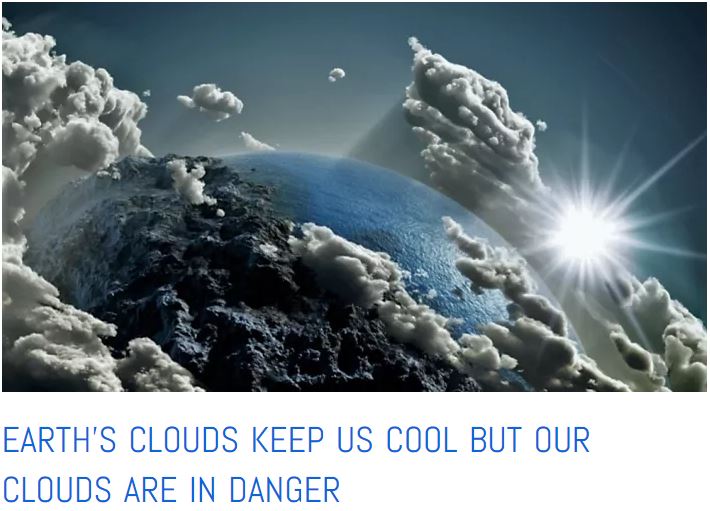
Clouds are in decline and as a result the loss of ‘shade’ for the oceans is producing widespread ocean warming and drought. – click to read more
All three of these well studied climatological phenomena are known to be associated with profound effects in limiting the growth of ocean pasture plankton, and in turn the slowing or shutting down the powerful plankton cooling effect. Plankton cooling is the result of healthy amount of ocean pasture plankton producing prodigious amounts of cloud forming ocean aerosols.
The additional cloudiness both shades the oceans and downwind lands which reduces the amount of moisture lost from land via evapo-transpiration keeping what water there is around. More clouds simultaneously are synonymous with a higher amount of available moisture in the air which in turn is seen as precipitation especially in regions where orographic effects, like the mountains of California, wring that moisture out of the air.
The authors of this new paper in Nature, who write in the language of climatology, point out that as long as warming forcing mechanisms are present, aka El Niño and La Niña, warming historically has extended California drought conditions more or less indefinitely, reports MacDonald et al.
Ed note: In my opinion as one speaking in the language of ocean ecology, which is the primary driver of ocean warming and hence climate warming, the real story the UCLA professors have uncovered is the history of the most powerful force in Nature, that of ‘plankton cooling’, as you read my review of this paper you might think plankton cooling when you read about the climatologists ‘warmings.’
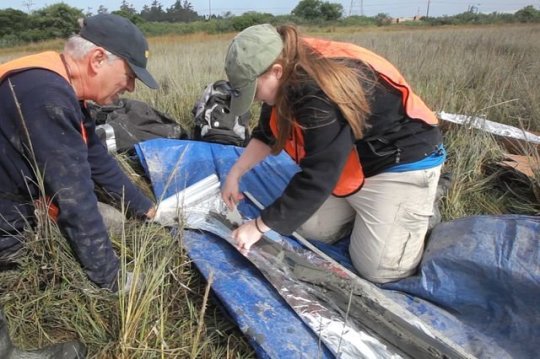
Prof. MacDonald and assistant collecting a sediment core sample for study
This fine paper proves that periods of prolonged ocean warming in the past appears to have had catastrophic effects in extending droughts. “When you have arid periods that persist for 60 years, as we did in the 12th century, or for millennia, as we did from 6,000 to 1,000 B.C., that’s not really a ‘California drought.’ That aridity is the new normal.” said UCLA Professor of climatology Glenn MacDonald
The researchers tracked California’s historic and prehistoric climate and water conditions by studying a sediment core from a lake in the Sierra Nevada mountains. They pulled a 2-inch-wide, 10-foot-deep cylinder of sediment from the bottom of Kirman Lake and analyzed it in third-of-an-inch sections, creating the most detailed and continuous paleoenvironmental record of California.
The team correlated their findings with other studies of California drought and climate history, and for the first time, united all the studies and cross-referenced them with histories of the Pacific Ocean’s temperature taken from marine sediment cores and other sources.
What they found was that periods of increased ocean warming could produce drought-like conditions that extended indefinitely.
Short term changes, those of a few years duration, in ocean temperatures are well-known and linked to what climatologist’s have named El Niño and La Niña conditions, which increase and decrease precipitation in California. Until now, no one had the long, detailed record of California’s dry periods needed to show that aridity went hand-in-hand with changes in the prehistoric sea surface temperature (SST) and climate records derived from the Pacific Ocean, MacDonald said.
“Climate models today have a challenging time predicting what will happen with Pacific sea-surface temperatures in the face of climate change, and we hope that our research can improve that,” he added.
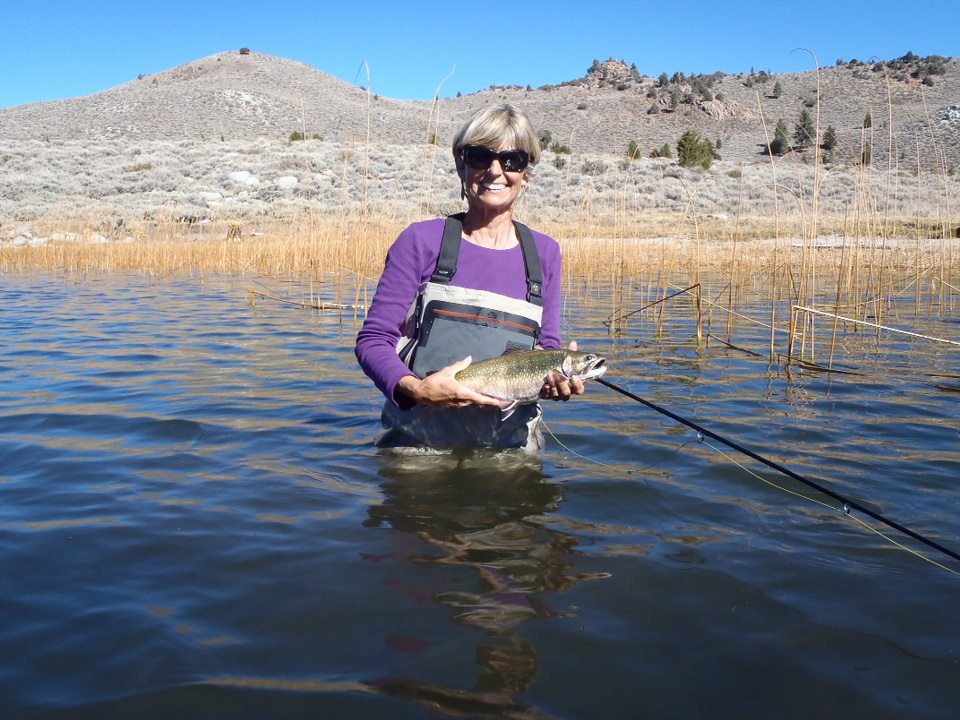
Kirman Lake today is a fabulous fly fishing lake filled with trout and a convenient drive from UCLA
The researchers chose Kirman Lake in central-eastern California Sierra Mountains for its sensitivity to climate changes and its stable geologic history. Today, it’s a small, freshwater lake full of trout and about 16 feet deep, with a small marsh at one edge.
The team found evidence though that through the millennia Kirman Lake has repeatedly grown more and less salty, dried until it was exclusively marshland and refilled again. All the while, sediment accumulated on the lake’s bottom, forming a detailed historical record of lake conditions, the changing precipitation/climate that blows in from the upwind airshed environment of the Pacific Ocean that is the source of all precipitation in California.
The research team spent years analyzing the lakes core sample, which revealed California’s history layer by layer for indicators of climate. For example the following:
- charcoal deposits indicate when wildfires were more prevalent.
- layers of fossilized pollen shows eras of more pine trees or drier sagebrush.
- shells from mollusks indicate times of deeper water.
- single-celled algae and molecules of carbon and nitrogen give clues to the lake’s depth and salinity, and the abundance or waning of plant and animal life.
From 6,000 to 1,000 B.C., during a time geologists refer to as the mid-Holocene, the core sample captures a 5,000-year dry period in California that has been seen in less detail through other paleoenvironmental records. This arid period is linked to an increase in the amount of solar energy, insolation, received by the North Pacific in cloudless summer months.
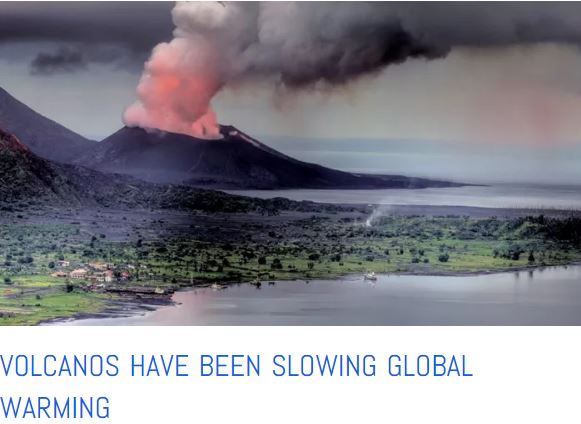
Volcano’s and their dust/ash are powerful natural mechanisms that slow global warming – click to read more
During the period 950 to 1250 B.C., a time known as the medieval climate anomaly. Increased ocean warming at this time is connected to decreased volcanic activity, aka a profound decrease in vital ocean mineral micronutrient dust which is well associated with abundance and declines in ocean pasture productivity. At that time the Pacific Ocean appears to have been in a warming cycle, or rather a collapse of its ‘plankton cooling’ cycle.
“We suspected we would see the millennia of aridity during the mid-Holocene at Kirman Lake, but we were surprised to see a very clear record of the medieval climate anomaly as well,” MacDonald said. “It was very cool to see the lake was sensitive on the scale of not just thousands of years, but also something that lasted just a few centuries.”
Even more exciting to the researchers was a brief shift in the record toward moister conditions around 2,200 B.C. In the middle of thousands of years of mid-Holocene dryness, Kirman Lake suddenly became moister again, MacDonald said.
“This change at 2,200 B.C. was a global phenomenon,” MacDonald said. “It’s associated with the collapse of the Old Kingdom in Egypt. It’s linked to the decline of the Akkadian Empire in Mesopotamia and similar Bronze Age societal disruptions in India and China. It was amazing to find evidence of it in our own backyard.”
That blip in the record was a reminder that ocean warming and cooling patterns have global repercussions. It also confirmed the accuracy and sensitivity of Kirman Lake’s record, and the strong link between the ocean and California’s weather.
All this has consequences for California, the researchers said. Drought-like conditions can last indefinitely as long as increased ocean warming is present, today’s worsening condition.
“In a century or so, we might see a retreat of forest lands, and an expansion of sagebrush, grasslands and deserts,” MacDonald said. “We would expect temperatures to get higher, and rainfall and snowfall would decrease. Fire activity could increase, and lakes would get shallower, with some becoming marshy or drying up.”
According to MacDonald California might remain an agricultural state, thanks to irrigation though productivity might decrease and crops might change. But he also emphasized that while the past is no guarantee of the future, in this case it does provide cause for concern.
Here’s What We Must Do To Avoid Centuries Of Drought And Disaster In California
Restoring Ocean Plankton Pastures: It Just Works! and it will likely bring back the rain
The simple fact is that the oceans have become and are becoming ever more desolate blue cloudless deserts. This is happening because the vital mineral micro-nutrients they require for their ocean pasture grass to grow, their phyto-plankton, is missing. Dust in the wind has been drastically reduced due to global greening effects of our high and rising CO2. This high CO2 has produced dramatic global greening and as we all know green stuff covers the ground… so here’s an easy mem to remember…
More grass growing means less dust blowing (follow this link to read more).
We can and we must return and replenish the mineral rich dust our fossil fuel age has denied the ocean pastures, I call this ocean pasture restoration OPR. As we do this they will return immediately to historic health and abundance. Fortunately this takes just a tiny tiny fraction of the time it has taken our industrial age to create the global CO2 crisis.
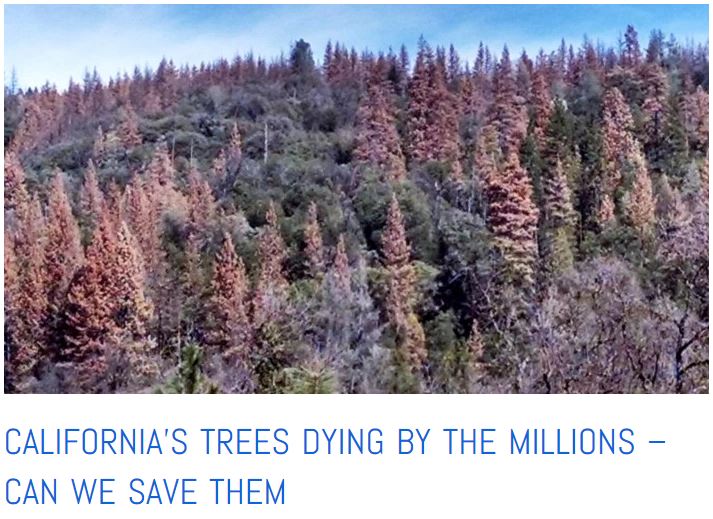
California drought can be promptly ended with the Better, Faster, Cheaper solution of ocean pasture restoration OPR – click to read more
By restoring ocean plankton cooling capacity to historic levels of health and abundance we will save our world at a cost of mere millions per year instead of the trillions of planned ‘carbon taxes’ to say nothing of what many demand is the return of modern technological societies to the stone age. Of course this OPR regeneration of the largest part of Nature, the 72% that is oceans, at such low-cost is anathema to those seeking their share of the trillion-dollar per year terrestrial solutions that cannot cure the crisis. Ces’t la vie.
The OPR solution it turns out is proven to be perfectly safe, sustainable, fast, and incredibly low-cost – I like to say it is ‘dirt cheap’ as dirt is the simple magic dust that the oceans are dying for lack of. Restoring the oceans will also bring back the fish.
The cost will be a scant few millions of dollars per year, easily affordable by the just a very few of we common people. The ocean pastures will return to historic health and abundance when, with our help, they repurpose billions of tonnes of CO2 into fresh ocean life, that is the simple scientific fact of photosynthesis.Regenerating ocean pastures in the World’s Seven Seas will mean billions of additional fish will every year fill fishermen’s nets to overflowing providing sufficient food to help end world hunger. When ocean pastures return to health and abundance it takes only a few years, 2-5, for these billions of additional fish to be providing nutritious food for all.
IT JUST WORKS!
Here’s a photo (below) that speaks a thousand words. In 2012 with just 10 shipmates I took a modest fishing boat out to sea in the NE Pacific. We carefully spread 100 tonnes of mineral dust on a dying ocean pasture. The cost of that blessed dust is less than $50,000 (fifty thousand dollars). The ocean pasture turned from being a blue desert into a lush green pasture. The very next year the fish came back, hundreds of millions of additional salmon.
My 2012 ocean pasture restoration project worked so well it brought back record salmon returns to Alaska the very next year where 50 million fish were expected to be caught instead 226 million were caught ( final tally). Scores of millions of meals of nutritious fish went from these nets onto the plates of American children via domestic food aid programs. The state of Alaska reports that those additional salmon caught resulted in $724 million dollars of economic stimulation in the state, not a bad ROI for the $72,000 dollars of minerals in my ocean health prescription!
(Parts of the above post is reprinted from materials provided by UCLA as press materials on the Nature paper.)









